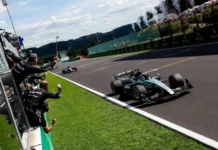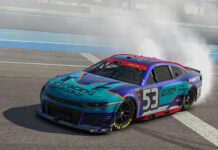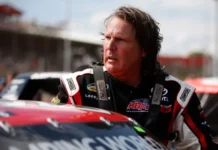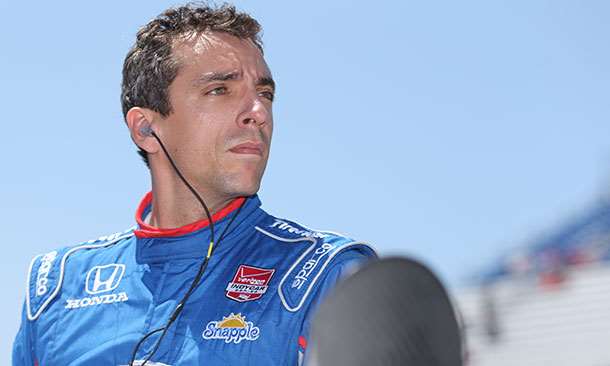One of Justin Wilson’s former IndyCar Series teammates called on open-wheel racing to formulate a better plan for protecting drivers heads in crashes.
Graham Rahal isn’t sure a covering like drag racing uses is the answer, but something similar is needed, he said.
Less than four years after Dan Wheldon was killed upon contact with a fence post at Las Vegas Motor Speedway, Wilson died Monday in a Pennsylvania hospital after being struck by another car’s crashed nose cone.
Wilson, a 37-year-old driver from Sheffield, England, died at Lehigh Valley Health Network after a severe head injury. IndyCar made the announcement on Monday night at Indianapolis Motor Speedway.
The news of his injury had shaken IndyCar’s competitors and fan base, leading to a #PrayersforJustin campaign on social media.
“More than ever we’ve got to be the first series to figure (protection) out,” Rahal said Monday before Wilson’s death was announced. “We have to.”
Last year, James Hinchcliffe was struck in the head by flying debris during the road race at Indianapolis Motor Speedway. He suffered a concussion. Formula One has had two recent instances of drivers being struck in the head, and former Champ Car World Series champion Cristiano da Matta suffered a severe head injury at the Road America circuit in Elkhart Lake, Wis., when his car hit a deer.
About the time of Wheldon’s crash, Brownsburg-based Don Schumacher Racing introduced a cover for its Top Fuel cars, and it was made at Aerodine Composites Group, an Indianapolis company. NHRA approved it for event use in 2012, but it’s not mandatory.
Tony Schumacher was the first driver to use it, and he’s heartbroken that IndyCar hasn’t developed something similar.
“That’s the exact reason I use it,” Schumacher said of Wilson’s injury. “I don’t know what’s coming off the car next to me, what’s coming out of the stands. I don’t know if I’m going to hit a bird. I’ve hit three birds. I’m going 330 mph and if (the bubble) can deflect it in some way, I’d like it to do that.
“I’ll say it for the millionth time: I’m glad it’s not mandatory, but I’m surprised everyone doesn’t use it. I wouldn’t drive a car without it.”
A dragster’s cover is hinged at the front and latches behind the driver’s head. Its lock can be released from the inside or the outside, and the enclosed compartment can be accessed by a fire hose.
“They need all the stuff we have,” Schumacher said. “After everybody’s looked at it, they go, ‘Jeesh, this thing is simple.’ We’re not trying to make it complicated, we’re trying to make it bulletproof.”
As for the view, Schumacher said his is better now than it was when the space was open, and it doesn’t vibrate.
Rahal is engaged to Funny Car driver Courtney Force, whose sister, Brittany, uses a cover in Top Fuel. Rahal said that exact system wouldn’t work for IndyCar because it’s held in place by two pins.
“With our risk of hitting fences and walls I’d be concerned about that thing popping open when you don’t want it to,” he said. “We’d have to be more creative.”
Rahal also noted that a drag race spans less than 4 seconds; Sunday’s race lasted 3 hours, 25 minutes.
“You can’t bake in there,” he said. “We have to think how we’d (design) it and build it.”
Schumacher’s answer: “Then put air conditioning in it.”
Bill Pappas has been an IndyCar engineer for more than two decades, and he spent four seasons working with Wilson. Pappas noted recent efforts to design a deflector, but that wouldn’t have kept this piece from hitting Wilson.
“It seemed to drop down out of the sky, and it’s hard to deal with that,” he said.
It’s also likely Wilson never saw the piece coming as his Andretti Autosport machine was the 12th car to come through the accident scene of race leader Sage Karam, whose car hit the outside wall with its nose.
An Indy car is designed to break apart during a crash in an effort to dissipate energy, although there is additional debris this year with the new bodywork kits distributed by Honda and Chevrolet. Just ahead of impact, Wilson darted out from behind James Jakes’ car.
Pappas estimated the nose cone that hit Wilson weighed 8 pounds.
“It’s a big piece,” he said. “The nose cone is long, and it’s heavy.”
Schumacher said IndyCar’s challenge, if it chooses this path, will be to shape a cover in such a way to allow proper visibility. An IndyCar, he noted, is significantly narrower than a dragster.
“The narrower you make (the piece), the harder it is to see straight,” he said. “I’m not saying IndyCar has to make mine fit theirs — nobody’s saying that — but maybe it’s just a bubble up there. But keeping things away from the driver’s head is what matters.
“They’ve got to do what they’ve got to do. Those drivers and their families are too important not to do something.”

















































